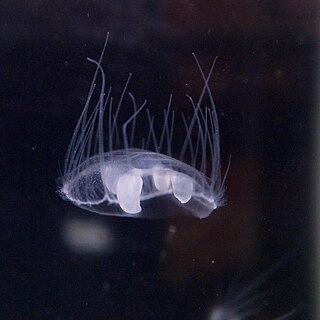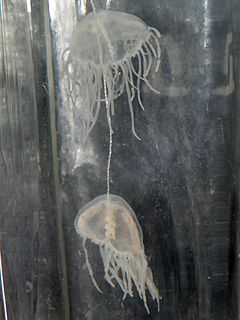 W
WOlindiidae is a family of hydrozoans in the order Limnomedusae. They have a polyp phase and a medusa phase. The polyps are generally small (1 mm) and solitary, but a few species are colonial. They have a varying number of tentacles and can reproduce by budding. In the largest species, the medusae can grow to 15 cm (6 in). Centripetal canals may be present or absent and the radial canals are unbranched. The gonads are beside the radial canals, except in Limnocnida, where they are on the manubrium. The fertilised eggs develop into planula larvae which become polyps. These multiply asexually or can bud off medusae. In some species, medusae are only produced when the water temperature exceeds a certain level. Most species are marine, but several can also be found in brackish water and a few, notably Craspedacusta and Limnocnida, are found in fresh water.
 W
WCraspedacusta is a genus of freshwater hydrozoans in the family Olindiidae.
 W
WCraspedacusta sowerbii or peach blossom jellyfish is a freshwater jellyfish in the phylum Cnidaria. Since it is classified as a hydrozoan, it is one of many jellyfish that are also known as hydromedusae. Hydromedusan jellyfish differ from scyphozoan jellyfish because they have a muscular, shelf-like structure called a velum on the ventral surface, attached to the bell margin. Originally from the Yangtze basin in China, C. sowerbii is an invasive species now found throughout the world in bodies of fresh water.
 W
WThe flower hat jelly is a species of hydrozoan in the family Olindiidae. Although they look like a jellyfish, they actually belong in the class Hydrozoa, while true jellyfish belong in class Scyphozoa. Flower hat jellies occur in the northwestern Pacific off central and southern Japan, and South Korea's Jeju Island.. The adult form of the flower hat jelly only lives a few months and is typically seen from December to July, with peaks in April and May. During the day they rest on the bottom, often among rocks or algae, but at night they float up to hunt for their prey, typically small fish.
 W
WGonionemus is a genus of hydrozoans that uses adhesive discs near the middle of each tentacle to attach to eelgrass, sea lettuce, or various types of algae instead of swimming. They are small and hard to see when hanging onto swaying seaweed. Nevertheless, they are capable of swimming when necessary. The bell is transparent, revealing the four orange to yellowish-tan gonads that lie along most of the length of the four radial canals. The pale yellow manubrium has four short, frilly lips. Up to 80 tentacles line the bell margin, with about an equal number of statocysts. Copepods are a favored prey.
 W
WGonionemus vertens, the clinging jellyfish, is a small species of hydrozoan in the family Olindiidae found in coastal regions throughout large parts of the Northern Hemisphere.
 W
WOlindias is a genus of hydrozoans in the family Olindiidae.
 W
WOlindias phosphorica, or cigar jellyfish, is a species of hydrozoan from the central and eastern Atlantic and the Mediterranean Sea.